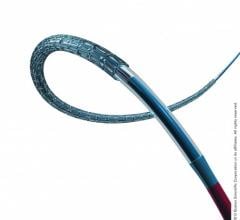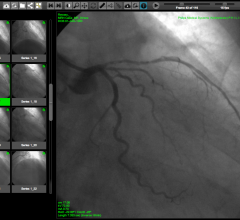Simbionix USA Corp. released the Endovascular Basic Skills training module for the ANGIO Mentor simulator. The Simbionix ANGIO Mentor is a virtual-reality training simulator that provides hands-on practice in a simulated environment for endovascular procedures. An expanding library of modules supports the acquisition and honing of procedural skills to build confidence and proficiency in various endovascular techniques and procedures.
In a significant milestone toward obtaining additional key regulatory approvals for the Synergy drug eluting stent system, Boston Scientific Corp. has completed enrollment in the EVOLVE II randomized, controlled clinical trial. The EVOLVE II trial is designed to further assess the safety and effectiveness of the Synergy stent system and support U.S. Food and Drug Administration (FDA) and Japanese regulatory approvals for the treatment of atherosclerotic coronary lesions. The Synergy stent uses the market-leading everolimus drug and features an ultra-thin directional polymer coating that is absorbed by the body shortly after drug elution ends at three months.
The new VitalView software from SunTech Medical provides physicians with a data management tool to help efficiently diagnose and treat patients. The new software works with the company’s non-invasive spot check device to reduce the risk for errors in clinical workflows.
Providing exceptional cardiovascular care for patients to achieve the best possible outcomes is the number one goal for ...
The injunction against sales of Medtronic's transcatheter heart valves in Germany — issued in a July 12, 2013, court ruling — has gone into effect, according to Edwards Lifesciences Corp. The District Court of Mannheim ruled that Medtronic is infringing Edwards' Spenser patent for transcatheter heart valve technology and issued an injunction prohibiting the sale of CoreValve and CoreValve Evolut systems in Germany, and ordered a recall of these products. Edwards has now provided the bond required to initiate the injunction.
Heart Imaging Technologies released the WebPAX cardiac echo reporting module.
Oklahoma State University Medical Center, located in Tulsa, Oklahoma, provides high-quality health services to rural and urban Oklahoma. The medical center has a partnership with Oklahoma State University Center for Health Sciences, providing a training ground for healthcare professionals across the region.
Cardiac positron emission tomography (PET) is growing in popularity among cardiologists because it provides the ability ...

Diagnostic imaging is generally considered safe and noninvasive, so it is extremely unusual for a patient to die from injuries received from a scanner. However, this was the case in early June when a patient was killed because a portion of a SPECT/CT scanner fell during the scan at the James J. Peters VA Medical Center in the Bronx, N.Y.
Vascular closure devices have a definite niche in areas where they were not originally intended but have found frequent off-label use because of their utility.

Vascular closure devices (VCD) were first introduced in the early 1990s with a goal to achieve quick hemostasis, thus reducing patients’ stay in the hospital (shorter time to ambulation) as well as faster turnover times for cardiac catheterization laboratories.
When performing radiofrequency (RF) ablation to treat cardiac arrhythmia, medical professionals must balance the safety ...
The use of 3-D echo can help improve the accuracy and reproducibility of cardiac quantification. The technology has the advantage of removing the inter-operator variability by imaging whole volume datasets of the heart, so specific images or organ views can be extracted and reconstructed in any position, similar to CT or MRI datasets. Also, because a volumetric dataset is captured, exam times can be shortened, instead of spending time trying to get just the right angle for a 2-D slice view. Cardiac quantification can also be improved by measuring the entire heart or ventricle, rather than just slices of it. New software also automates this quantification.
Atherotech Diagnostics Lab has added three new genetic tests to its cardiometabolic test offering: warfarin sensitivity, Plavix sensitivity and the thrombophilia risk test.
The U.S. Food and Drug Administration (FDA) Circulatory System Devices Panel of the Medical Devices Advisory Committee will review two new technologies to help treat heart failure (HF) Oct. 8-9, 2013.
Change Healthcare Cardiology Hemodynamics is an integrated hemodynamic monitoring system for monitoring vital signs and ...
Abbott promised preliminary results from a study presented at the ESC Congress 2013, suggesting that its high sensitive troponin test may help doctors improve the diagnosis and prognosis of patients presenting with symptoms of a heart attack. [1] The test could be particularly beneficial for women, who may have different presenting symptoms and are often under-diagnosed. [2] The study, which is being conducted by researchers at the University of Edinburgh, is evaluating Abbott's Architect Stat High Sensitive Troponin-I (hsTnI) test, which received CE mark in January 2013.

The main results of the large randomized LINC study, which compared the effectiveness of the Lucas mechanical chest compression system to high quality manual chest compressions, were presented at the European Society of Cardiology Congress in Amsterdam, the Netherlands. The LINC study showed similar short-term survival rates for Lucas (23.6%) and manual (23.7%) chest compressions. At six-months, 8.5% of the patients treated with LUCAS were alive with good neurological outcomes compared to 7.6% in the manual group.

Direct Flow Medical Inc. announced the first patient enrollment in the U.S. SALUS clinical trial. The trial will study the Direct Flow Medical Transcatheter Aortic Heart Valve System, which encompasses a distinctive transcatheter aortic heart valve with a metal-free frame and flexible, low-profile delivery system designed to eliminate aortic regurgitation. The device is intended to improve the long-term survivability of aortic stenosis patients by resolving the clinical issues associated with current commercial valves.


 September 18, 2013
September 18, 2013








